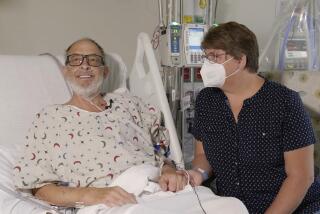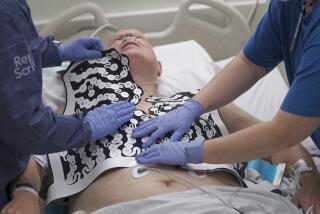Help for tiny hearts
Donor organs are scarce enough for adults with heart failure. For infants and young children, the prognosis can be even grimmer.
Not only are fewer organs available, the hearts of the very young can fail suddenly, without the symptoms that older people usually exhibit. Although mechanical heart pumps are routinely used to help adolescents and adults buy some time, they’re too big for small children.
Now an experimental artificial heart may help even tiny newborns live long enough to find a donor or recover on their own. Called the Berlin Heart, the miniaturized pump is a scaled-down version of one of the heart-assist devices used by adults. At least a dozen such devices have been approved in the U.S. for use in adults, but none are available for young children.
“This is a wonderful advance because what we use now is more hazardous, and only works short term,” says Dr. Mark Plunkett, a pediatric heart transplant surgeon at UCLA’s Geffen School of Medicine.
Young children and infants most commonly suffer from heart failure because of congenital heart defects or because their heart becomes inflamed by a viral infection. Although far more adults need heart transplants, they’re also more likely to receive a donated organ. In 2004, 3.9% of those waiting for a heart transplant were younger than 5, but 9.3% of those who died waiting for a donor heart were younger than 5, according to the United Network of Organ Sharing in Richmond, Va.
Currently, the only treatment option for small children awaiting transplant is a machine used as a bridge to transplant. Called an “ECMO” for extra corporeal membrane oxygenation machine, it keeps the blood oxygenated and is modeled on the heart-lung bypass machine used for open-heart surgery.
But it doesn’t help the failing heart do its job -- and it can cause serious complications. To prevent blood clots that can clog the machine, patients must take blood thinners, which can lead to dangerous internal bleeding. Plus, they must be bedridden while tethered to the device, and they usually only survive for a few weeks before their organs start to fail.
“We never know how long we’re going to have to wait for a heart and ECMO support can only be used for a week or two,” says Dr. Marc Pelletier, a cardiothoracic surgeon at Stanford University.
In contrast, the Berlin Heart has been used for more than 100 days in a child waiting for a suitable organ, and on newborns just a few days old. “There is no age limit,” says Rene Garo, chief executive of Berlin Heart, the German company that makes the pump.
The mechanical device, which mimics the action of a pumping heart, is connected to the heart and blood vessels through a pair of tubes that are surgically inserted through the chest wall. It siphons off blood from one heart chamber and pumps it into the lungs and body, taking over 50% to 75% of the failing organ’s workload.
Although children must still be hospitalized, they’re attached to a stationary drive unit that resembles a portable nightstand, which allows them to move around. “They can sit in a playpen or a bouncy chair so they’re somewhat active,” Pelletier says.
Since the Berlin Heart was adapted for infants and young children in 1990, about 150 children have used it worldwide, including 24 in the United States and Canada. More than two-thirds of them survived, either receiving a transplant or recovering. “These children would have died otherwise,” says Pelletier, who implanted the Berlin Heart in a 2-year-old girl last month.
The device is widely used in Europe, but it is not approved in the U.S. It is deployed here on a compassionate use basis, which means hospitals must ask the Food and Drug Administration for special permission to import it. Because of a child’s fragile condition, time is of the essence when these requests are made.
Once the makers of the Berlin Heart receive the emergency FDA waiver, they try to ship the equipment, which is normally accompanied by a heart surgeon, a technician and an engineer, on the next U.S.-bound plane out of Berlin.
“This is a major undertaking and everything else in the company is dropped,” says Garo.
An analysis of the European cases reveals that survival rates are a little less than 70%, which is comparable to rates for heart-assist devices used in adults.
The company plans to apply for an FDA humanitarian exemption later this year and hopes the device will be more readily available in the U.S. in early 2006. The exemption would allow hospitals to stock the Berlin Heart so that they wouldn’t need an FDA clearance and import it from Germany every time it was needed.
“Right now, a kid could die while we’re pushing paper,” Plunkett says.
*
(BEGIN TEXT OF INFOBOX)
Options for older kids
Although the Berlin Heart is the only mechanical device for children younger than 5, older children have a few more options.
Last year, the FDA approved the first heart-assist device for children ages 5 to 16. Called the MicroMed DeBakey VAD (ventricular assist device), the fully implantable pump improves the blood flow of a failing heart, is the size of a C cell battery, and weighs less than 4 ounces.
A few adult cardiac pumps have been used successfully in older children, such as the Thoratec VAD, which has been implanted in 101 patients between ages 7 and 17. The survival rate was 68.8% for this group.






